Ouvrages du Libron in Vias
The Ouvrages du Libron structure was built between 1855 and 1857 and was a real technical achievement!
During periods when water levels are very high, this structure allows the waters of the Libron to pass up over the canal. Today, it is operated by VNF employees in much the same way as in the 19th century. This structure has been listed a Historic Monument since 1996.
The water levels of the Libron river are often very high
The Libron is a coastal river that originates in Laurens in the French department of Hérault and then flows into the Mediterranean at the town of Vias, just after crossing paths with the Canal du Midi.
This crossing wasn't particularly problematic during the first half of the 18th century because the river crossed the canal in several places. But the growing population of Vias meant that the Libron needed to be better contained so that more of the available land in the town could be utilised.
In around 1750, the canal and the Libron crossed paths in just one location and the sediments brought into the canal by the rising waters of the river sometimes clogged up the canal.
A first proposal was a mobile pontoon set up in 1767
A study was carried out in 1757 in an effort to avoid costly construction work and suspension of navigation on the canal due to high water levels on the Libron. Several proposals were put forward and one of them was selected in 1764, then implemented in 1767. The idea was to organise the crossing in a very limited area.
The waters of the river couldn't cross an aqueduct because there wasn't enough of a slope, so they needed to pass up over the canal! But how?
By using a pontoon that stretched right across the width of the canal. The pontoon was stored next to the structure and put in place when storms were expected. The excess waters of the Libron would therefore flow over it much like a drainage pipe. The sand and gravel would pass over the pontoon and therefore wouldn't be deposited onto the canal bed. Very quickly, this structure proved to be a success.
It was improved over time and used for almost a century. The only drawback was that during these periods when the water level was high, the position of the pontoon meant that boats couldn't pass through and navigation was suspended.
An idea for improvement was put forward in 1826
As a solution to this problem, the head of the Agde division, engineer Loysel, came up with a system in 1826 to evacuate the excess waters at two separate locations that were opened one after the other. This idea was not accepted by the general manager and so was never implemented...
When the Compagnie du Canal du Midi made some significant investments such as Orb aqueduct in Béziers, to ensure the waterway was able to face the competition from the railroad, the issue of the Libron was put back on the table.
In 1853, Urbain Maguès, who was chief civil engineering engineer and general manager of the canal at the time, reconsidered Loysel's idea. He drew the plans for the system of mobile aqueducts that would provide an alternative path for the Libron river.
His plan was accepted in 1854. The work was approved by decree by Napoleon III on 10 February 1855 (Imperial decree for the improvement of navigation at the crossing of the Orb river in Béziers, the Libron river and the Hérault river in Agde).
Construction work began immediately and the new system was completed and open to navigation in 1857.

Libron à Vias sur canal du Midi © VNF
The Ouvrages du Libron,
where water passes up over the canal
This structure separates the Libron into two branches. When a boat approaches, the waters of the river are directed to a mobile aqueduct up over the canal on the side furthest away from the boat.
The boat can enter through a channel and wait in a chamber at the centre. Another mobile aqueduct is then positioned over the canal behind the boat.
The waters of the Libron are then diverted once again. The mobile aqueduct in front of the boat is moved to the sides to allow the boat to pass.
There are two advantages to this system because it not only avoids suspending navigation, but it also prevents deposits in the canal and the associated issues of dredging.
The Ouvrages du Libron structure was presented at the Great London Exhibition of 1862 at France's public works pavilion. Urbain Maguès and Achille Simonneau were awarded a prize for their project.
This structure is still used today by VNF staff in charge of managing the canal, in much the same way as when it was first built.















